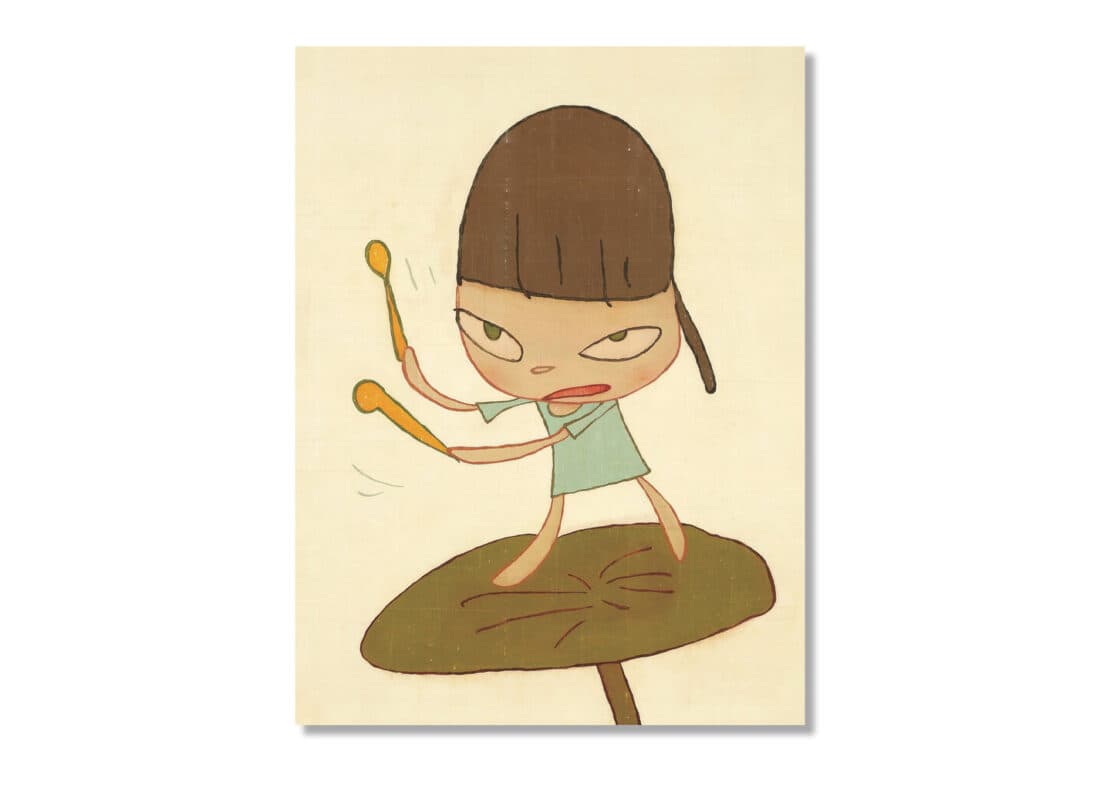Born in Post-War Japan and raised during the reconstruction of the island nation, renowned artist Yoshitomo Nara is from the small city of Hirosaki. The foundation of his early life always included art and punk music, which would later mold his work. Nara would study and refine his craft at the Aichi Prefectural University of Fine Arts and Music. The cartoonish yet eerie art style synonymous with Yoshitomo Nara has received mainstream recognition arguably since the 2000s.
The deceptively simple yet deep messaging of Nara’s art was featured as cover imagery for prominent music artists, including R.E.M, The Star Club, Shonen Knife, Bloodthirsty Butchers, and other musicians from his native Japan.
Today, Nara is a household name in the pop art ecosystem along with the likes of KAWS and Takashi Murakami. Yoshitomo Nara art prints are revered for their exclusivity and collectibility, seeping into street and hype culture like some of his well-known contemporaries. While Yoshitomo Nara art prints look rudimentary at first glance, each piece holds a deeper meaning, open to interpretation in the eyes of the beholder.
What Kind of Art Does Yoshitomo Nara Make?
Yoshitomo Nara hails from Japan’s pop art movement alongside other prominent artists like Takashi Murakami, Yasumasa Morimura, and Aya Takano. Conceived in the 1990s, the pop art movement brought forth a new generation of Japanese artists putting their own spin on vibrant, sometimes manga-inspired illustrations, foregrounding individuality.
Nara’s art appears elementary at first glance — simple colors, minimally detailed characters, and an emphasis on cartoon-like motifs give viewers a surface-level understanding of Nara. After a few moments, it’s evident there are details within each work that convey darker, menacing undertones.
The Real One Print from Yoshitomo Nara exemplifies these themes perfectly. Ahead of Dallas Contemporary’s reopening in January 2021 which coincided with a Yoshitomo Nara exhibit, the museum announced it was releasing an exclusive print from the Japanese artist. The Yoshitomo Nara Real One Print Large (Open Edition) features Nara’s iconic girl figure – which appears throughout his work – holding a pair of scissors in one hand and a teddy bear in the other. An ominous, sly smile is displayed on the girl as she stares at the scissors. A skull pendant in the child’s hair intimates the theme of death in the print.
The position of the teddy bear is also important. Nara focuses the viewer’s attention on the scissors before the eye glances at the bear dangling from the other arm. While the connection between the two motifs isn’t explicit, it can be inferred that the girl, with a menacing smile, may be up to no good.
These subtle details that can change the feeling of a painting are evident in all of Nara’s work. Yet the meanings are usually ambiguous: if a viewer doesn’t want to read into the darker undertones of Nara’s art, they don’t have to. His work is vibrant, easy to follow, and innocuous to someone who isn’t paying much attention to the minutia in each piece. But the deeper, darker meanings behind the work of Yoshitomo Nara have gained him a cult following over the years that continues to grow. Each of his works typically features a child-like figure with exaggerated proportions. Perhaps the children featured in Nara’s work symbolize innocence in a world filled with violence and sorrow.
Why is Yoshitomo Nara So Popular?
The simplistic nature of Nara’s work allows for the mass appeal of his art prints, while also captivating art enthusiasts with deeper messaging.
Like his contemporaries, Yoshitomo Nara’s work has transcended the art world receiving praise and mainstream acclaim in street culture and fashion. His art prints are limited, driving up the hype around each release and inevitably the price. Nara’s art stands as a valuable asset for collectors, but are also great works that can be displayed in virtually any setting thanks to the apparent simplicity of the work.
The Takeaway
Since the 2000s, the work of Yoshitomo Nara has received mainstream appeal across many mediums including music, street culture, and the art community. His exhibits have been showcased in his native Japan and across the world, including at MoMA, and the Museum of Contemporary Art, Los Angeles.
Don’t be fooled by the deceptively simple nature of Yoshitomo Nara’s art. Punk music during Nara’s youth and the memory of World War II in Japan fueled what is often described as “horror-like” imagery evident in his work.
While much of Nara’s art is open to interpretation, there is a haunting aura around each piece which is often overlooked at first glance. The elusiveness behind every piece will continue to captivate the minds of people around the world as Nara has solidified himself as one of the most prominent contemporary artists of his time.



































